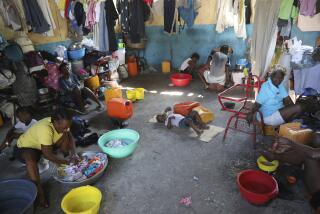A New Nail in Haiti’s Coffin
- Share via
FORET DES PINS, Haiti — In a musty shop near the capital’s dilapidated cemetery, Josue Termidor takes a rasp, gently sanding a coffin made of avocado tree planks. A decade ago, the casket would have been carved from heavy mahogany.
“All the good wood is gone,” said Termidor, 32, his fingernails caked with putty used to seal the brittle wood. “It’s got harder to make a living, and the lack of wood makes families disappointed and the dead angry.”
Once blanketed by lush forests, Haiti is now nearly 90% deforested. Competing against a demand that has far exceeded supply, the impoverished Caribbean nation loses more than 30 million trees a year to provide wood, fuel and work to a desperate population.
“In a good month, I earn 200 Haitian ($40) and that’s barely surviving. The peasants cutting down the trees make even less,” said Termidor, flanked by a metallic mauve “tete-boeuf” or first-class coffin, considered the Cadillac of caskets.
President Jean-Bertrand Aristide, leader of the poorest nation in the Western Hemisphere, has been unable to tackle poverty, unemployment and political instability, let alone the environmental tragedy.
Efforts have been stymied by government and opposition rivalries, with millions of dollars in international aid suspended since flawed 2000 legislative elections. Some was earmarked for environmental projects.
“We face a total ecological disaster,” Aristide said in an interview last month. “Misery and the lack of education are making people cut more trees....
“When you learn how to write ‘tree,’ you also learn at the same time what to do instead of cutting a tree,” he said. “Unfortunately, without money ... [there is] less education and more people involved in cutting trees.”
Money would allow the government to prosecute illegal loggers and pursue an aggressive literacy plan to teach people the value of trees, he said.
But trees are vulnerable even at Foret des Pins, the Pine Forest National Park that is one of Haiti’s few protected areas.
A “No Tree Cutting” sign hangs above the entrance to the forest, on the border with the Dominican Republic. Trash is scattered about the giant pine trees, which have deep hack marks in their thin trunks. Loggers make nightly journeys here, slowly hacking away at the trees until they fall. The next day, they’re on a truck to the capital.
“The problem is simple; just stop cutting down the trees,” said Joel Joseph, a Ministry of Agriculture forest ranger. “But you have to have the resources to educate people and to enforce the law. I say the problem is simple, but deep down, I know we’re headed for disaster.”
In 12 years, he has watched his forest disappear before his eyes, from nearly 94,000 acres to about 34,500. Roadblocks are set up to stop illegal loggers, and logs are confiscated. But rangers lack the power to arrest them.
Political instability has also accentuated the despair, pushing hundreds of people to the forests for a source of income.
“When there are political problems in Port-au-Prince, more people come up here with chain saws,” Joseph said. “Every weekend, I try to take my son into the forest to show him the trees. I’m afraid when he’s my age, there won’t be any left.”
The scarcity also affects farmers. With no tree roots to hold the soil, topsoil has disappeared and fewer vegetables can grow. Some farmers also report a change in weather.
“Because there are fewer trees, there’s also less rain,” said farmer Cedner Jean, 40. “Dew allows us to grow cabbage, potatoes and beans, but we can’t grow anything else anymore.”
In his village of Thiote, few families have electricity; most use charcoal to cook. About 80% of Haiti’s 8.2 million people rely on charcoal for cooking.
At Port-au-Prince’s main port, battered ships lumber up to the docks to deliver giant bags of charcoal from other parts of the country. Some carry planks from avocado and mango trees that once provided food.
It takes a dozen planks, costing $60, to make Termidor’s shoddy casket. Each sells for about an average of $200. Before making a profit, he must pay seven employees, the rent and transport for the planks.
Coffins are potent symbols in Haiti, where properly burying the dead is tantamount to ensuring protection for the living. Without sturdy coffins, families risk angering the spirits. But without wood, Termidor risks angering grieving families and his employees.
For Termidor, “it’s a good business because more people are dying.” When he began 15 years ago, he made nine coffins a month. Now he makes 15. “But without trees, we’re all going to end up dead.”
More to Read
Sign up for Essential California
The most important California stories and recommendations in your inbox every morning.
You may occasionally receive promotional content from the Los Angeles Times.













